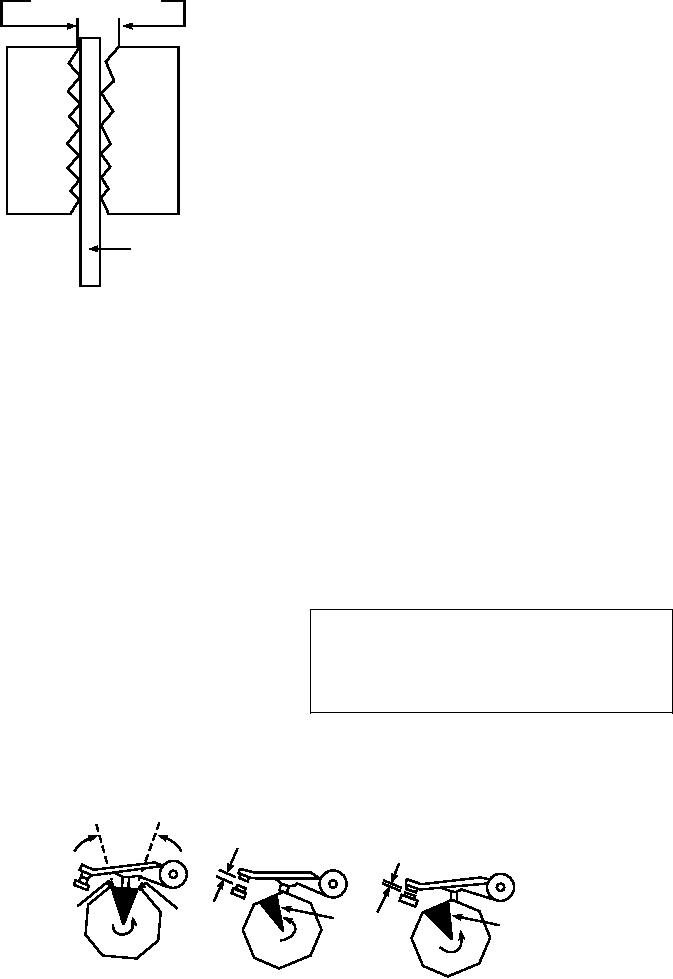
ACTUAL GAP .022
If the point gap decreases, dwell increases; if point
gap increases, dwell decreases. Point gap and dwell are
inversely proportional.
Once the point gap has been set, the breaker arm
spring tension should be checked. Use an accurate
ounce scale. If the pressure is excessive, rapid wearing
of the rubbing block can cause the point gap to narrow,
retarding the engine timing and increasing the dwell.
Too low a pressure can cause the points to bounce,
creating a high-speed miss.
With the rubbing block positioned on the low point
.015
between cam lobes, hook the scale at the contact point
FEELER
GAUGE
edge. Pull at right angles to the moveable arm, and
check the pressure just as the points separate. Compare
ASf06050
Figure 6-50.--False setting given by feeler gauge for used
to the manufacturer's specifications. If the pressure is
points.
incorrect, refer to the applicable maintenance manual
for adjustment procedures. Ensure that all wires are
correctly connected and clear of all moving parts.
gap is excessive, saturation time for the coil is reduced
Remove rags that were used to plug openings.
and high-speed missing occurs.
Apply a thin coat of high-temperature grease to the
The gap for new points may be set initially with a
breaker cam. Do not use engine oil or low-temperature
feeler gauge. This is done by turning the breaker cam
grease as it will be thrown off and onto the points. On
until the point rubbing block is on the highest point of
distributors equipped with a felt wick oiler under a
the cam lobe, and then moving the stationary point plate
lift-off rotor, moisten with engine oil (3 to 5 drops).
until a feeler gauge of the correct thickness is a snug fit
Lubricate the point pivot pin and bushing, the
between the contacts. Refer to the manufacturer's
centrifugal advance mechanism, and the breaker plate
specifications for the correct gap.
bearing surfaces very lightly with engine oil. If an
As shown in figure 6-50, however, used points
outside oiler is provided, apply 5 to 7 drops of engine
cannot be gapped accurately with a feeler gauge. The
oil.
gauge measures between the high spots while the actual
point opening is much greater. Note that a .015 feeler
gauge is a snug fit, but the actual gap is .022. The best
CAUTION
method of obtaining the necessary accuracy for setting
used points is the use of a dwell meter.
Lubricate distributor parts sparingly. Lubri-
cant on the points may cause rapid burning.
Dwell (often called cam-angle) refers to the
distance in degrees of breaker cam rotation that the
breaker cam revolves from the time the points close
If you have a distributor test machine, use it to
until they are opened again (fig. 6-51). The dwell for
check the distributor for dwell, vacuum and centrifugal
any given set of breaker points is controlled by the point
advance, point bounce, bent shaft, worn bushings, worn
gap, so the two must be considered together.
breaker cam, etc.
DWELL
LARGE GAP
SMALL GAP
POINTS
POINTS
SMALL
LARGE
OPEN
OPEN
DWELL
DWELL
CORRECT DWELL/
CORRECT GAP
ASf06051
Figure 6-51.--Relationship of dwell and point gap.
6-46

